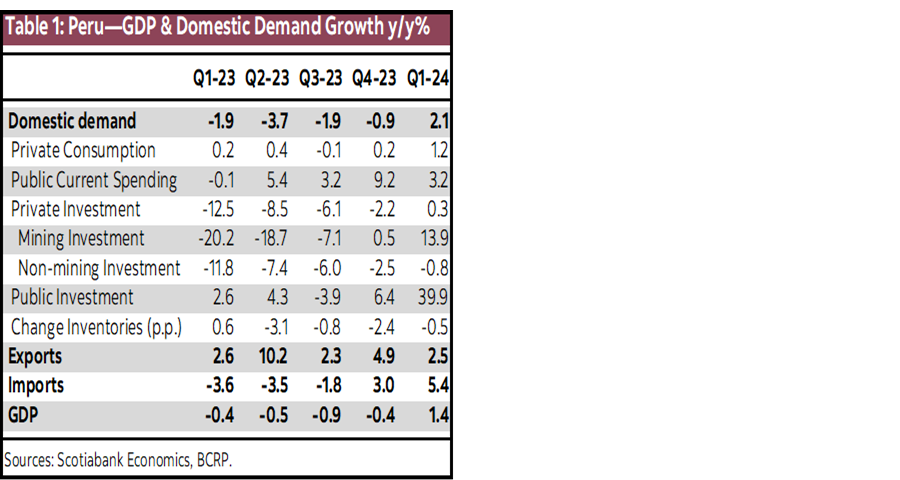- Peru: Q1 GDP growth is led by public sector pending; the private sector to follow soon
The BCRP released the first quarter GDP and domestic demand growth figures on May 24th. Although the figure of 1.4% YoY aggregate GDP growth was known, the breakdown was not, and came as a partial relief.
We already knew the figure for Q1-24 GDP growth (1.4% YoY), and that this was the first quarter of positive growth since 2022. What was reassuring was that all components showed positive growth as well, including private investment (albeit, barely, 0.3%), see chart 1. Furthermore, although exports fared well, the fact that domestic demand growth, up 2.1%, also outpaced GDP was encouraging.

But a closer look reveals some cracks that still need to be mended, especially in the private sector. It was clearly public sector spending that led growth in Q1-24. Of course, it is not bad that public investment increased nearly 40% YoY in Q1. The concern is that this is not triggering, at least not yet, a consequential increase in private investment. Mining investment rose a healthy 13.9%, but that has its own dynamics, and was off a very low base. The hope was that non-mining investment would start showing some life in Q1. It didn’t. Non-mining investment, down 0.8% YoY, in the quarter, decreased for the fifth consecutive quarter, also off a very low base. This is a glass half empty, glass half full situation. What a relief that private investment is finally growing, and what a disappointment that this growth goes no further than mining. Peru’s post-recession recovery will only gather strength once non-mining investment begins to perform.
Looking at GDP growth overall, the glass does look rather more than half full going forward. Growth in the first quarter should be the lowest for the year. There are a number of reasons why one may be optimistic despite the weak private sector demand figures during Q1. These include the upsurge in metal prices that has been taking place, the increase in household resources from pension fund and worker compensation withdrawals in Q2 and Q3, the restoring impact of lower inflation on real wages, declining interest rates, and the energy the government has been putting into accelerating infrastructure projects and permits for mining. With all these tailwinds, we remain comfortable with our forecast of 2.7% GDP growth in 2024, and even see some upside to it. If only politics do not get in the way.

—Guillermo Arbe
DISCLAIMER
This report has been prepared by Scotiabank Economics as a resource for the clients of Scotiabank. Opinions, estimates and projections contained herein are our own as of the date hereof and are subject to change without notice. The information and opinions contained herein have been compiled or arrived at from sources believed reliable but no representation or warranty, express or implied, is made as to their accuracy or completeness. Neither Scotiabank nor any of its officers, directors, partners, employees or affiliates accepts any liability whatsoever for any direct or consequential loss arising from any use of this report or its contents.
These reports are provided to you for informational purposes only. This report is not, and is not constructed as, an offer to sell or solicitation of any offer to buy any financial instrument, nor shall this report be construed as an opinion as to whether you should enter into any swap or trading strategy involving a swap or any other transaction. The information contained in this report is not intended to be, and does not constitute, a recommendation of a swap or trading strategy involving a swap within the meaning of U.S. Commodity Futures Trading Commission Regulation 23.434 and Appendix A thereto. This material is not intended to be individually tailored to your needs or characteristics and should not be viewed as a “call to action” or suggestion that you enter into a swap or trading strategy involving a swap or any other transaction. Scotiabank may engage in transactions in a manner inconsistent with the views discussed this report and may have positions, or be in the process of acquiring or disposing of positions, referred to in this report.
Scotiabank, its affiliates and any of their respective officers, directors and employees may from time to time take positions in currencies, act as managers, co-managers or underwriters of a public offering or act as principals or agents, deal in, own or act as market makers or advisors, brokers or commercial and/or investment bankers in relation to securities or related derivatives. As a result of these actions, Scotiabank may receive remuneration. All Scotiabank products and services are subject to the terms of applicable agreements and local regulations. Officers, directors and employees of Scotiabank and its affiliates may serve as directors of corporations.
Any securities discussed in this report may not be suitable for all investors. Scotiabank recommends that investors independently evaluate any issuer and security discussed in this report, and consult with any advisors they deem necessary prior to making any investment.
This report and all information, opinions and conclusions contained in it are protected by copyright. This information may not be reproduced without the prior express written consent of Scotiabank.
™ Trademark of The Bank of Nova Scotia. Used under license, where applicable.
Scotiabank, together with “Global Banking and Markets”, is a marketing name for the global corporate and investment banking and capital markets businesses of The Bank of Nova Scotia and certain of its affiliates in the countries where they operate, including; Scotiabank Europe plc; Scotiabank (Ireland) Designated Activity Company; Scotiabank Inverlat S.A., Institución de Banca Múltiple, Grupo Financiero Scotiabank Inverlat, Scotia Inverlat Casa de Bolsa, S.A. de C.V., Grupo Financiero Scotiabank Inverlat, Scotia Inverlat Derivados S.A. de C.V. – all members of the Scotiabank group and authorized users of the Scotiabank mark. The Bank of Nova Scotia is incorporated in Canada with limited liability and is authorised and regulated by the Office of the Superintendent of Financial Institutions Canada. The Bank of Nova Scotia is authorized by the UK Prudential Regulation Authority and is subject to regulation by the UK Financial Conduct Authority and limited regulation by the UK Prudential Regulation Authority. Details about the extent of The Bank of Nova Scotia's regulation by the UK Prudential Regulation Authority are available from us on request. Scotiabank Europe plc is authorized by the UK Prudential Regulation Authority and regulated by the UK Financial Conduct Authority and the UK Prudential Regulation Authority.
Scotiabank Inverlat, S.A., Scotia Inverlat Casa de Bolsa, S.A. de C.V, Grupo Financiero Scotiabank Inverlat, and Scotia Inverlat Derivados, S.A. de C.V., are each authorized and regulated by the Mexican financial authorities.
Not all products and services are offered in all jurisdictions. Services described are available in jurisdictions where permitted by law.

